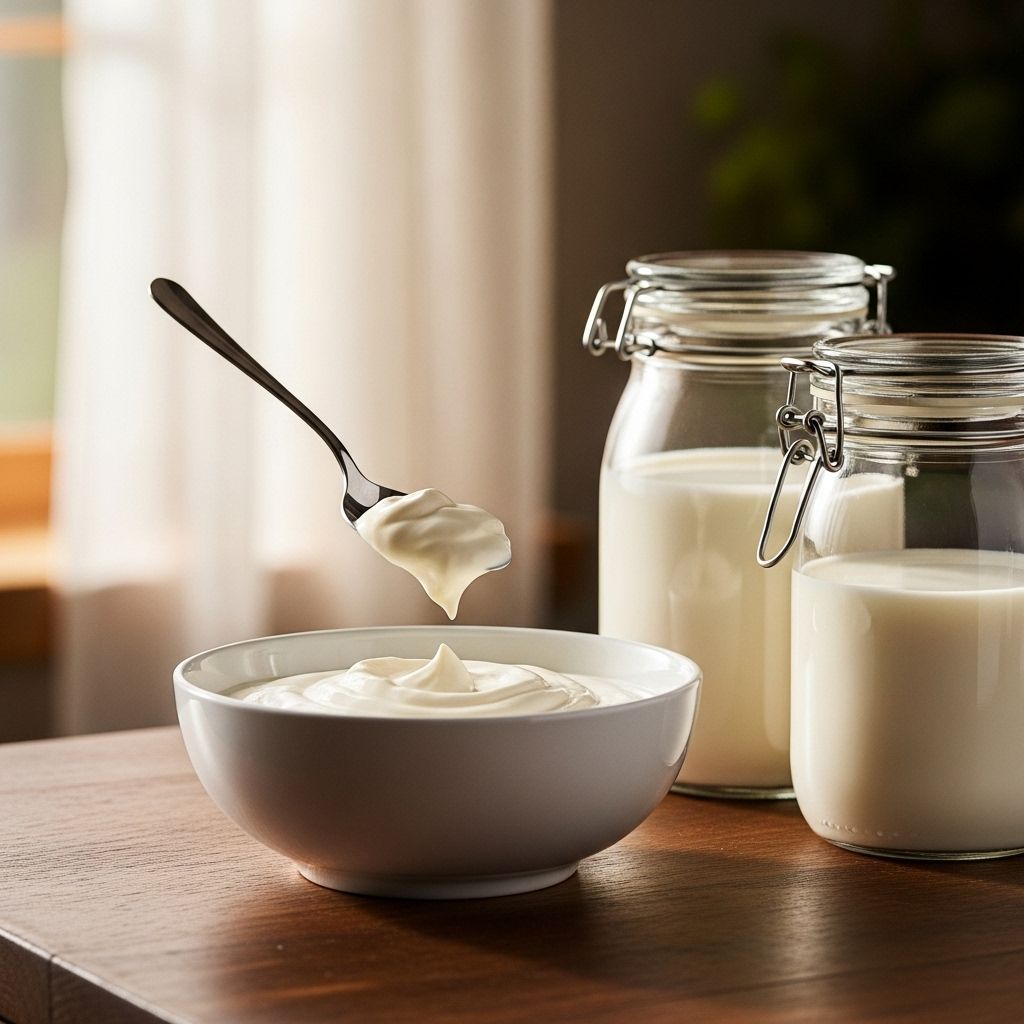How to Make Crème Fraîche at Home in One Simple Step
A foolproof fermentation method to achieve silky, tangy cream for elegant cooking.

Crème fraîche, with its luxurious texture and delicately tangy flavor, is an essential ingredient in French cuisine. It enriches sauces, lends a subtle complexity to soups, dollops beautifully on fresh fruit, and elevates both savory and sweet creations. While gourmet stores often carry crème fraîche with hefty price tags, learning to make it at home puts this versatile dairy delight within easy reach. In this article, we’ll walk step-by-step through the process of making crème fraîche at home, demystifying the science behind fermentation, troubleshooting each stage, and providing you with professional tips on usage and storage. Whether you’re a passionate home cook or someone looking to add a touch of French elegance to your dishes, this guide is for you.
What Is Crème Fraîche?
Crème fraîche (pronounced krem fresh) is a cultured cream with a consistency similar to thickened heavy cream, yet with a silkiness all its own. Hailing from France, it is created by introducing live bacterial cultures into fresh cream, which ferment the sugars and thicken the mixture. The result is wonderfully rich and tangy, with a fat content generally higher than its American cousin, sour cream.
- Texture: Smooth, thick, and spoonable
- Flavor: Rich and tangy, but less sour than sour cream
- Uses: Swirled into soups, sauces, desserts, or enjoyed atop fruit
Crème Fraîche vs. Sour Cream
Many home cooks wonder if crème fraîche and sour cream can be used interchangeably. While both are cultured dairy products, their composition and flavor profiles set them apart:
| Attribute | Crème Fraîche | Sour Cream |
|---|---|---|
| Fat Content | ~30%–45% | ~18%–20% |
| Flavor | Rich, tangy, nutty | More tart, less rich |
| Texture | Super creamy, thick, doesn’t curdle | Less creamy, prone to curdling |
| Cooking Uses | Can be boiled; won’t split | Prone to splitting at high heat |
Crème fraîche’s higher fat content makes it ideal for finishing sauces, as it melts smoothly and resists curdling, unlike sour cream.
The Ingredients: Just Two!
One of the greatest appeals of homemade crème fraîche is its simplicity—only two primary ingredients are required:
- Heavy Cream: Use a high-quality, pasteurized (not ultra-pasteurized) heavy cream with at least 36% fat. Ultra-pasteurized cream is heated to higher temperatures, which inhibits the helpful bacteria needed for fermentation.
- Cultured Buttermilk: This provides the live bacterial culture essential to ferment the cream and develop that signature tang and thick texture. Opt for cultured buttermilk, not the ‘traditional’ buttermilk which is often a byproduct of butter and lacks live cultures.
That’s it! No thickeners, additives, or stabilizers—just two wholesome ingredients.
Step-By-Step Guide to Making Crème Fraîche
1. Combine the Cream and Buttermilk
In a clean glass jar or bowl, pour:
- 2 cups heavy cream
- 2 tablespoons cultured buttermilk
Mix gently to combine—agitation is not necessary, as the bacteria will do all the work.
2. Cover and Let Sit at Room Temperature
Cover the jar or bowl loosely with a clean kitchen towel, cheesecloth, or plastic wrap.
- A loose cover keeps out debris while allowing air circulation for the culture to breathe.
- Let the mixture stand at room temperature (68–75ºF/20–24ºC) for 12–24 hours.
- The mixture will thicken and develop a pleasant tang; the time needed depends on the ambient temperature—slightly shorter for warmer rooms and slightly longer for cooler ones.
3. Stir, Taste, and Refrigerate
Once the mixture has thickened to a custard-like or spoonable consistency and smells pleasantly tangy (like yogurt or buttermilk):
- Stir gently to homogenize.
- Seal the container tightly and refrigerate for at least 4 hours. The flavor will continue to develop and the cream will thicken further as it chills.
Tips and Troubleshooting
- Choosing Your Cream: Always use pasteurized (not ultra-pasteurized) heavy cream for best results. Cream labeled “ultra-pasteurized” has been heated to higher temperatures, damaging the proteins required for thickening.
- Fermentation Temperature: If your room is very cold, the process may take longer, or may not thicken sufficiently. Place the jar in a warm spot (such as an unheated oven with just the oven light on) to maintain temperature.
- If It’s Not Thickening: Check your buttermilk isn’t expired and is labeled “cultured.” Also ensure your cream isn’t ultra-pasteurized.
- Sour Smell or Off Flavors: Trust your senses! Crème fraîche should have a clean, slightly tangy aroma—never sharp, rotten, or offensive. If in doubt, discard and start over with fresh ingredients.
How to Use Crème Fraîche
One of crème fraîche’s greatest joys is its versatility. Here are a few classic and contemporary ways to enjoy your homemade batch:
- Sauces: Enrich and finish pan sauces for fish, chicken, or pork without fear of curdling.
- Soups: Swirl in for creaminess and subtle tang right before serving.
- Desserts: Pair with fresh berries, poached fruits, or as a topping for cakes and tarts.
- Breakfast: Spread on toast with smoked salmon or serve alongside scrambled eggs for a touch of luxury.
- Dips & Dressings: Use in place of sour cream for dips, salad dressings, or drizzled over roasted vegetables.
Substitution Guide
While crème fraîche has a unique flavor and culinary character, in a pinch you can substitute plain full-fat yogurt or sour cream, though the results will differ in richness and stability when heated. Homemade crème fraîche, however, delivers the best texture and versatility.
Storing Crème Fraîche
Homemade crème fraîche will keep in your refrigerator for up to two weeks, thanks to its acidic nature which inhibits spoilage.
- Always store in a clean, airtight container.
- Use a clean spoon each time to avoid introducing contaminants.
- The flavor may intensify slightly as it ages, developing more tang.
Frequently Asked Questions (FAQs)
Q: Can I use ultra-pasteurized cream?
No, ultra-pasteurized cream usually fails to thicken due to destroyed proteins and the lack of viable bacteria for culturing. Always opt for pasteurized cream.
Q: Is it safe to leave dairy out at room temperature?
Yes—for this process, the high acidity produced by the bacterial cultures suppresses harmful bacteria, making it safe so long as you use fresh ingredients and proper hygiene.
Q: Can I use a yogurt starter?
Traditional crème fraîche requires buttermilk, but you can use plain, cultured yogurt with live active cultures in a pinch. The flavor and thickness may be slightly different.
Q: How do I know when it’s ready?
It should be thick, velvety, and have a pleasant tang reminiscent of fresh yogurt. If it hasn’t thickened after 24 hours, check room temperature and starter freshness.
Q: How long does homemade crème fraîche last?
Stored in a clean, airtight jar in the refrigerator, homemade crème fraîche will keep for up to two weeks. If you notice any pink, green, or fuzzy mold, discard immediately.
Crème Fraîche in Global Cuisine
While crème fraîche is a hallmark of French kitchens, it effortlessly bridges international culinary traditions. In Eastern Europe, it is akin to Russian smetana or Central European schmand. Chefs worldwide deploy crème fraîche to enrich curries, top spicy chilis, or bring silky smoothness to pasta dishes.
In Summary: The One-Step Method
Making crème fraîche is nothing short of magical—a small, deliberate transformation that yields something greater than the sum of its parts. The basic steps to remember:
- Mix heavy cream and buttermilk in a clean jar
- Let culture at room temperature until thickened
- Stir, refrigerate, and enjoy!
Homemade crème fraîche rewards you with superior taste, texture, and endless possibilities for creative cooking.
Try It Yourself!
With just a few minutes of hands-on time and a day’s patience, you can bring a touch of French charm to your kitchen. Experiment with it in both savory and sweet applications, and soon, you’ll wonder how you ever lived without it.
Quick Reference Recipe Card
| Ingredient | Quantity |
|---|---|
| Pasteurized Heavy Cream | 2 cups (475ml) |
| Cultured Buttermilk | 2 tablespoons (30ml) |
Instructions:
1. Combine cream and buttermilk in a glass jar.
2. Cover loosely, let sit at room temperature 12–24 hours or until thickened.
3. Stir and refrigerate. Use within 2 weeks.
Further Reading & Resources
- Dairy Science: Explore the microbial role in culturing dairy for a deeper understanding of fermentation.
- French Cuisine: Learn more about traditional French sauces and how crème fraîche plays a starring role.
- Homemade Yogurt & Cheese: Making crème fraîche is just the beginning—discover other cultured dairy products to try.
Bring a little luxury to your table—start with homemade crème fraîche!
References
Read full bio of Srija Burman












